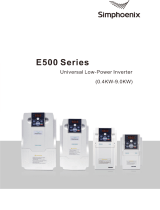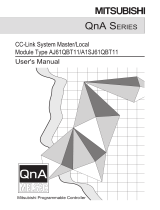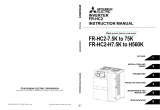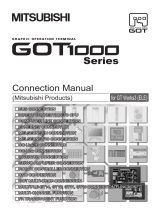Page is loading ...

FR-A7NC E kit INSTRUCTION MANUAL
E
INVERTER
INVERTER
Plug-in option
INSTRUCTION MANUAL
INVERTER
1
2
3
4
5
6
7
8
9
HEAD OFFICE: TOKYO BUILDING 2-7-3, MARUNOUCHI, CHIYODA-KU, TOKYO 100-8310, JAPAN
FR-A7NC E kit
communication function
IB(NA)-0600340ENG-E(1512) MEE Printed in Japan Specifications subject to change without notice.
PROGRAMMING EXAMPLES
HOW TO CHECK FOR ERROR USING THE LEDS
PRE-OPERATION INSTRUCTIONS
INSTALLATION
WIRING
INVERTER SETTING
FUNCTION OVERVIEW
I/O SIGNAL LIST
DETAILS OF INPUT AND OUTPUT SIGNALS

A-1
Thank you for choosing this Mitsubishi Inverter plug-in option.
This Instruction Manual gives handling information and
precautions for use of this equipment. Incorrect handling might
cause an unexpected fault. Before using the equipment, please
read this manual carefully to use the equipment to its optimum.
Please forward this manual to the end user.
1. Electric Shock Prevention
This section is specifically about
safety matters
Do not attempt to install, operate, maintain or inspect this
product until you have read through this Instruction Manual and
appended documents carefully and can use the equipment
correctly. Do not use this product until you have a full
knowledge of the equipment, safety information and
instructions.
In this Instruction Manual, the safety instruction levels are
classified into "WARNING" and "CAUTION".
Incorrect handling may cause
hazardous conditions, resulting in
death or severe injury.
Incorrect handling may cause
hazardous conditions, resulting in
medium or slight injury, or may cause
only material damage.
The level may even lead to a serious
consequence according to conditions. Both instruction levels
must be followed because these are important to personal
safety.
WARNING
CAUTION
CAUTION
SAFETY INSTRUCTIONS
WARNING
While the inverter power is ON, do not remove the front cover
or the wiring cover. Do not run the inverter with the front
cover or the wiring cover removed. Otherwise you may
access the exposed high voltage terminals or the charging
part of the circuitry and get an electric shock.
Even if power is OFF, do not remove the front cover except for
wiring or periodic inspection. You may accidentally touch the
charged inverter circuits and get an electric shock.
Before wiring or inspection, power must be switched OFF. To
confirm that, LED indication of the operation panel must be
checked. (It must be OFF.) Any person who is involved in
wiring or inspection shall wait for at least 10 minutes after the
power supply has been switched OFF and check that there
are no residual voltage using a tester or the like. The
capacitor is charged with high voltage for some time after
power OFF, and it is dangerous.
Any person who is involved in wiring or inspection of this
equipment shall be fully competent to do the work.
The plug-in option must be installed before wiring. Otherwise,
you may get an electric shock or be injured.
Do not touch the plug-in option or handle the cables with wet
hands. Otherwise you may get an electric shock.
Do not subject the cables to scratches, excessive stress,
heavy loads or pinching. Otherwise you may get an electric
shock.

A-2
2. Injury Prevention
3. Additional Instructions
Also the following points must be noted to prevent an accidental
failure, injury, electric shock, etc.
1) Transportation and mounting
2) Trial run
3) Usage
4) Maintenance, inspection and parts replacement
5) Disposal
6) General instruction
CAUTION
The voltage applied to each terminal must be the ones
specified in the Instruction Manual. Otherwise burst, damage,
etc. may occur.
The cables must be connected to the correct terminals.
Otherwise burst, damage, etc. may occur.
Polarity must be correct. Otherwise burst, damage, etc. may
occur.
While power is ON or for some time after power-OFF, do not
touch the inverter as they will be extremely hot. Doing so can
cause burns.
CAUTION
Do not install or operate the plug-in option if it is damaged or
has parts missing.
Do not stand or rest heavy objects on the product.
The mounting orientation must be correct.
Foreign conductive objects must be prevented from entering
the inverter. That includes screws and metal fragments or
other flammable substances such as oil.
CAUTION
Before starting operation, each parameter must be confirmed
and adjusted. A failure to do so may cause some machines to
make unexpected motions.
WARNING
Do not modify the equipment.
Do not perform parts removal which is not instructed in this
manual. Doing so may lead to fault or damage of the inverter.
CAUTION
When parameter clear or all parameter clear is performed, the
required parameters must be set again before starting
operations because all parameters return to the initial value.
For prevention of damage due to static electricity, nearby
metal must be touched before touching this product to
eliminate static electricity from your body.
CAUTION
Do not test the equipment with a megger (measure insulation
resistance).
CAUTION
This inverter plug-in option must be treated as industrial
waste.
Many of the diagrams and drawings in this Instruction Manual
show the inverter without a cover or partially open for
explanation. Never operate the inverter in this manner. The
cover must be reinstalled and the instructions in the inverter
manual must be followed when operating the inverter.

I
— CONTENTS —
1 PRE-OPERATION INSTRUCTIONS 1
1.1 Unpacking and product confirmation ..............................................................................................1
1.1.1 Product confirmation.......................................................................................................................................1
1.2 Parts....................................................................................................................................................2
1.3 Inverter option specifications...........................................................................................................4
1.4 CC-Link version .................................................................................................................................5
1.4.1 CC-Link ver. 1.10............................................................................................................................................5
1.4.2 CC-Link ver. 2.................................................................................................................................................5
2 INSTALLATION 6
2.1 Pre-installation instructions .............................................................................................................6
2.2 Installation procedure .......................................................................................................................6
3 WIRING 12
3.1 System configuration example.......................................................................................................12
3.2 Connection of several inverters .....................................................................................................13
3.3 Connection cable .............................................................................................................................16
3.4 Wiring................................................................................................................................................16
4 INVERTER SETTING 20

II
4.1 Parameter list ...................................................................................................................................20
4.2 Operation mode setting...................................................................................................................21
4.2.1 Operation mode indicator .............................................................................................................................21
4.2.2 Operation mode switching and communication startup mode (Pr. 79, Pr. 340) ...........................................22
4.3 Operation at communication error occurrence ............................................................................24
4.3.1 Operation selection at communication error occurrence (Pr. 500 to Pr. 502) ..............................................24
4.3.2 Fault and measures......................................................................................................................................28
4.4 Inverter reset ....................................................................................................................................29
4.5 CC-Link function setting .................................................................................................................31
4.5.1 Station number setting (Pr. 542)...................................................................................................................31
4.5.2 Baud rate setting (Pr. 543) ...........................................................................................................................32
4.5.3 Frequency command with sign (Pr. 541)......................................................................................................33
5 FUNCTION OVERVIEW 34
5.1 Function block diagram ..................................................................................................................34
5.2 Output from the inverter through network ....................................................................................35
5.3 Input to the inverter through network............................................................................................36
6 I/O SIGNAL LIST 37
6.1 CC-Link extended setting (Pr. 544) ................................................................................................37
6.2 I/O signal list.....................................................................................................................................38
6.2.1 I/O signal when CC-Link ver.1 one station (FR-E500 series compatible) is occupied (Pr. 544 = 0) ............38
6.2.2 I/O signal when CC-Link ver.1 one station is occupied (Pr. 544 = "1") ........................................................41

III
6.2.3 I/O signal when CC-Link ver.2 double setting is selected (Pr. 544 = "12")...................................................42
6.2.4 I/O signal when CC-Link ver.2 quadruple setting is selected (Pr. 544 = "14") .............................................43
6.2.5 I/O signal when CC-Link ver.2 octuple setting is selected (Pr. 544 = "18") ..................................................44
7 DETAILS OF INPUT AND OUTPUT SIGNALS 46
7.1 Details of remote input and output signals ...................................................................................46
7.1.1 Output signals (master module to inverter (FR-A7NC)) ...............................................................................46
7.1.2 Input signals (inverter (FR-A7NC) to master module) ..................................................................................48
7.2 Details of remote register................................................................................................................51
7.2.1 Remote register (master module to inverter (FR-A7NC)).............................................................................51
7.2.2 Remote register (inverter (FR-A7NC) to master module).............................................................................54
7.2.3 Instruction codes ..........................................................................................................................................57
7.2.4 Monitor codes...............................................................................................................................................61
8 PROGRAMMING EXAMPLES 62
8.1 Program example for reading the inverter status.........................................................................65
8.2 Program example for setting the operation mode........................................................................66
8.3 Program example for setting the operation commands ..............................................................67
8.4 Program example for monitoring the output frequency ..............................................................68
8.5 Program example for parameter reading.......................................................................................69
8.6 Program example for parameter writing........................................................................................70
8.7 Program example for setting the running frequency ...................................................................71
8.8 Program example for fault record reading ....................................................................................73

IV
8.9 Program example for resetting the inverter at inverter error ......................................................74
8.10 Instructions ......................................................................................................................................75
9 HOW TO CHECK FOR ERROR USING THE LEDS 77
9.1 When one inverter is connected.....................................................................................................77
9.2 When two or more inverters are connected ..................................................................................79
9.3 Communication stops during operation........................................................................................81

1
1
1 PRE-OPERATION INSTRUCTIONS
1.1 Unpacking and product confirmation
Take the plug-in option out of the package, check the product name, and confirm that the product is as you
ordered and intact.
This product is a plug-in option for the FR-E700 series inverters (with standard control circuit terminal
specifications) and the FR-E700EX series drive units.
For using the FR-E700EX series, use this Instruction Manual assuming that the term "inverter" means
"drive unit", and the term "frequency (0.01Hz increments)" means "rotation speed (1r/min increments)".
1.1.1 Product confirmation
Check the enclosed items.
* Only for the FR-E720-3.7K (FR-E720-175) or lower and FR-E740-7.5K (FR-E740-170) or lower.
Plug-in option ...................................1
Mounting screw (M3
×
6mm)
............. 2
(Refer to page 8, 10.)
Terminal block.................................. 1
(Refer to page 8, 10.)
Front cover for plug-in option ...........1
(Refer to page 8, 10.)
Option protective cover
* ................. 1
(Refer to page 8.)
Option small cover (Not used) ......... 1
CAUTION
Install a provided front cover for plug-in option, in place of the inverter front cover.
SD
L.RUN
RD
L.ERR
RUN
SW2
ON
12

2
PRE-OPERATION INSTRUCTIONS
1.2 Parts
SD
L.RUN
RD
L.ERR
RUN
SW2
Operation status indication LED
Lit/flicker of the LED indicate operation status.
Terminal
layout
SW2
DA
DB
DG
SLD
FG
Front view Rear view
Mounting
hole
Mounting hole
Mounting
hole
Terminating resistor selection switch
Select the resistor value of the terminating resistor.
Connector for
communication
Mount the
accessory
terminal block to
connect to the
network.
Connector
Connect to the inverter option connector.
ON
12
ON
12
(Refer to page 13.)
(Refer to page 3.)
(Refer to page 16.)

3
PRE-OPERATION INSTRUCTIONS
1
Operation status indication LED
LED Description
L.RUN
Lit when refresh data is properly received. Turns OFF when a data transmission is stopped for a
certain period of time.
L.ERR
Lit when a communication error occurs in the own station and flickers when settings of switch, etc.
are changed while power is ON.
Flickers when the Pr. 542 or Pr. 543 setting is changed.
Turn the power ON again or turn the RES signal ON. (Refer to page 31, 32.)
RUN
Lit during normal operation (5V is supplied in the board) (Lit even in the noncommunication status.)
Flickers when the master station is CC-Link ver.1 and the FR-A7NC is CC-Link ver.2 compatible.
(Refer to page 5.)
SD Turns OFF when no data is transmitted.
RD Lit when the received data carrier is detected.
REMARKS
Set the station number using Pr. 542 Communication station number (CC-Link). (Refer to page 31.)
Set transmission baud rate using Pr. 543 Baud rate selection (CC-Link). (Refer to page 32.)

4
PRE-OPERATION INSTRUCTIONS
1.3 Inverter option specifications
Option Type Inverter plug-in, terminal block connectable
Power Supply 5VDC supplied from the inverter
Number of
Connectable Units
42 units at max. (Refer to page 37 for the number of stations occupied.)
Can be used in combination with other options.
Cable Size
0.3mm
2
to 0.75mm
2
Station Type Remote device station
Number of Stations
Occupied
CC-Link ver.1: one station occupied
CC-Link ver.2: one station occupied (selectable from among double, quadruple and octuple)
Communication Cable CC-Link dedicated cable, CC-Link dedicated cable compatible with version 1.10

5
PRE-OPERATION INSTRUCTIONS
1
1.4 CC-Link version
1.4.1 CC-Link ver. 1.10
The conventional CC-Link, defined as ver. 1.00, has the restriction on the inter-station cable length. The
improved CC-Link, defined as ver. 1.10, can support 20cm or longer inter-station cable.
Refer to the instruction manual of CC-Link master module for the maximum overall cable lengths and inter-
station cable lengths for CC-Link ver. 1.00 and ver. 1.10.
1.4.2 CC-Link ver. 2
The FR-A7NC is compatible with CC-
Link ver.2.
When using the CC-Link ver.2 setting
with the FR-A7NC, the master station
also needs to be compatible with the
CC-Link ver.2.
For CC-Link ver.2, double, quadruple
and octuple settings can be used to
increase the remote register (RWr/w)
points.
CC-Link ver. 1.10 compatibility conditions
1) All modules that comprise a CC-Link system should be compatible with CC-Link ver. 1.10.
2) All data link cables should be CC-Link ver. 1.10 compatible, CC-Link dedicated cables.
(CC-Link ver. 1.10 compatible cables have a logo or ver. 1.10 indication.)
CAUTION
In a system that is composed of the mixed modules and cables compatible with CC-Link version 1.00 and
the ones compatible with version 1.10, the maximum overall cable length and inter-station cable length are
compatible with CC-Link version 1.00 specifications.
Master station
(CC-Link ver.1)
Master station
(CC-Link ver.2)
CC-Link ver.1
setting
CC-Link ver.1
setting
CC-Link ver.2
setting
CC-Link ver.2
setting
Communication
enabled
Communication
enabled
Communication
enabled
Communication
disabled
("RUN" LED flickers)

6
2 INSTALLATION
2.1 Pre-installation instructions
Make sure that the input power of the inverter is OFF.
2.2 Installation procedure
CAUTION
Do not mount or remove the plug-in option while the input power is ON. Otherwise, the inverter
and plug-in option may be damaged.
Static electricity in your body must be discharged before you touch the product. Otherwise the
product may be damaged.
CAUTION
Always perform wiring to the main circuit terminals and control circuit terminals
before installing the option. Wiring cannot be performed after installing the
option.
For wiring to terminals RUN, FU, and SE of control circuit terminal, run cables as
shown in the right figure to prevent them from being caught between the option
board and control circuit terminal block. In case cables are caught, the inverter
may be damaged.
When the inverter cannot recognize that the option unit is mounted due to
improper installation, etc., " " (option fault) is displayed.
When mounting/removing an option, hold the sides of the option. Do not press
on the parts on the option circuit board. Stress applied to the parts by pressing, etc. may cause a failure.
Take caution not to drop mounting screws during the mounting and removal of the option.
Pull the option straight out when removing. Pressure applied to the connector and to the option circuit
board may break the option.
Plug-in
option
Plug-in
option
Plug-in
option

7
INSTALLATION
2
Inverter with one front cover
(1) Remove the front cover of the inverter. (For details on how to remove the front cover, refer to the
Instruction Manual (Applied) of the inverter.)
(2) The PU cover on the front cover needs to be removed. Open the PU cover with a screwdriver, etc. and
force it to swing open widely in the direction shown by the arrow in the figure below until it is off its
hinges.
REMARKS
• Because the voltage class, model name, and SERIAL number (voltage class only for FR-E740-5.5K (FR-E740-120)
or higher) are written on the PU cover, the PU cover needs to be installed on the supplied front cover (the front
cover for plug-in option) as a substitute for the initial PU cover on it.
(1) Front cover
(2) PU cover
*
* Force the PU cover to swing open widely in the
direction shown by the arrow until it is off.

8
INSTALLATION
(3) Install the option protective cover.
(4) Securely fit the connector of the plug-in option to the inverter connector along the guides.
(5) Securely fix the both top and bottom of the plug-in option to the inverter with the accessory mounting
screws (tightening torque 0.33N•m to 0.40N•m). If the screw holes do not line up, the connector may
not have been plugged securely. Check for loose plugging.
(6) Remove a PU cover on the supplied front cover for plug-in option to replace a PU cover with the PU
cover removed from the original front cover in step (2).
(7) Mount the already wired terminal block to the plug-in option. (Refer to Chapter 3 for wiring.)
(8) Install the front cover for plug-in option to the inverter.
REMARKS
The protective structure (JEM1030) applied to the inverter without optional protective cover shall be the open type
(IP00).
(4)
(5)
(8)
(6) Replace
(7)
Mounting screws
Front cover
for plug-in option
(3) Option protective cover
Option connector
of inverter

9
INSTALLATION
2
Inverter with two front covers
(1) Remove the front covers 1 and 2 of the inverter. (For details on how to remove the front covers, refer
to the Instruction Manual (Applied) of the inverter.)
(2) Remove the PU cover from the front cover 2. For removing the PU cover, refer to page 7.
REMARKS
• Because the voltage class is written on the PU cover, the PU cover needs to be installed on the supplied front cover
(the front cover for plug-in option) as a substitute for the initial PU cover on it.
Front cover 1
Front cover 2
(1)
(2)
PU cover
(1)

10
INSTALLATION
(3) Install the front cover 1 to the inverter.
(4) Securely fit the connector of the plug-in option to the inverter connector along the guides.
(5) Securely fix the both top and bottom of the plug-in option to the inverter with the accessory mounting
screws (tightening torque 0.33N
•m to 0.40N•m). If the screw holes do not line up, the connector may
not have been plugged securely. Check for loose plugging.
(6) Remove a PU cover on the supplied front cover for plug-in option to replace a PU cover with the PU
cover removed from the original front cover 2 in step (2).
(7) Mount the already wired terminal block to the plug-in option. (Refer to Chapter 3 for wiring.)
(8) Install the front cover for plug-in option to the inverter.

12
3 WIRING
3.1 System configuration example
(1) Programmable controller side
Mount the "RJ61BT11", "QJ61BT11N", "L26CPU-BT", "L26CPU-PBT", "LJ61BT11", "A1SJ61QBT11" or
"A1SJ61BT11", "CC-Link system master/local module" on the main or extension base unit having the
programmable controller CPU used as the master station.
(2) Inverter side
Mount the option (FR-A7NC) on the inverter.
(3) Connect the programmable controller CC-Link module master station and the terminal block supplied with the
FR-A7NC with the CC-Link dedicated cable. After connecting the terminal block to the FR-A7NC, fit the front
cover.
REMARKS
• When the CPU has automatic refresh function (example: QnA series CPU)
When the END instruction is executed by the programmable controller CPU, the buffer memory is automatically refreshed to
enable communication with a remote device.
• When the CPU does not have automatic refresh function (example: AnA series CPU)
Sequence ladder logic is configured to perform direct communication with the buffer memory of the master station and to
enable communication with a remote device.
CC-Link dedicated cable
Inverter
Motor Motor
Power
supply
Inverter
Power
supply
Terminating
resistor
Terminating
resistor
Up to 42
units can be
connected
when only
inverters are
connected
QJ61BT11N,
etc.
Master station
Remote device station
Manual of the CC-Link master station
RJ61BT11 type
CC-Link System Master/Local Module
User's Manual ...SH-081270ENG
QJ61BT11N type
CC-Link System Master/Local Module
User's Manual ...SH-080394E
L26CPU-BT type/L26CPU-PBT type/LJ61BT11 type
CC-Link System Master/Local Module
User's Manual ...SH-080895ENG
A1SJ61QBT11 type
CC-Link System Master/Local Module
User's Manual ...IB-66722
A1SJ61BT11 type
CC-Link System Master/Local Module
User's Manual ...IB-66721

13
WIRING
3
3.2 Connection of several inverters
An inverter can join the link system as a CC-Link remote device station, and such device stations can be
controlled and monitored with a user program of a programmable controller. These devices can be useful
components of an automated factory.
For the shield cable of the CC-Link dedicated cable, connect it to "SLD" of each unit and always earth
(ground) it via "FG".
Terminals SLD and FG are connected inside the unit.
*1 Use the terminating resistors supplied with the programmable controller.
*2 For the unit in the middle, set 1 and 2 of SW2 to OFF (without terminating resistor).
*3 Perform setting of the terminating resistor selection switch (SW2).
(Refer to page 2 for the position of the switch.)
When connecting a terminating resistor separately, do not use a built-in
terminating resistor. (SW2 1-OFF, 2-OFF)
Shielded
twisted cable
DA
DB
DG
SLD
FG
Terminating
resistor
*1
Terminating
resistor
selection
switch (SW2)
*3
Master module
Blue
White
Yellow
FR-A7NC*2
FR-A7NC
Shielded
twisted cable
DA
DB
DG
SLD
FG
DA
DB
DG
SLD
FG
Blue
White
Yellow
12
OFFOFF
ON OFF
OFF ON
ON ON
Description
Without
terminating
resistor
130Ω
Do not use.
110Ω
ON
12
ON
12
ON
12
ON
12
130 is a resistance value for the CC-Link
ver.1.00 dedicated high performance
cable.
/





